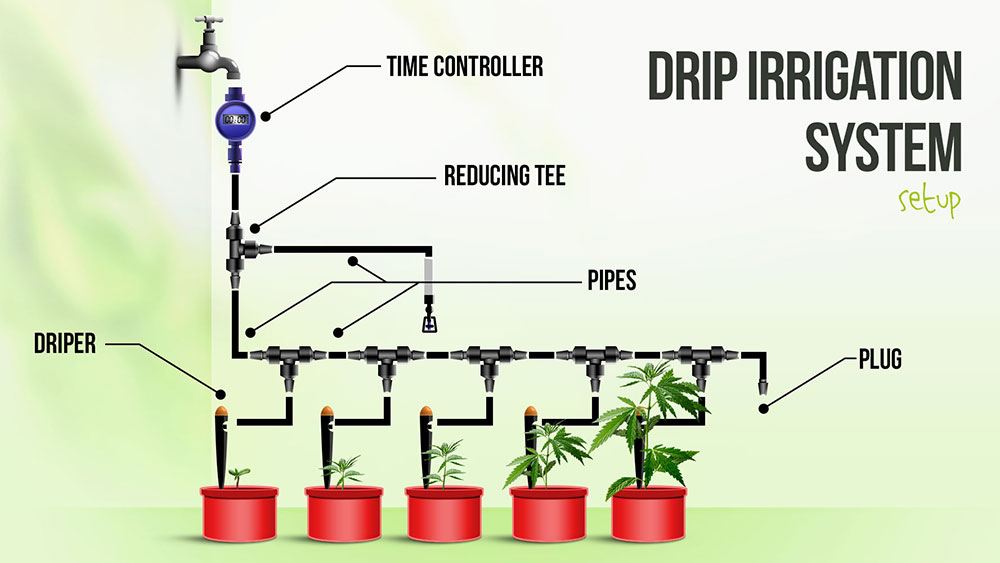Water-saving irrigation is carried out from specific engineering measures, so it is necessary to know the water-saving irrigation engineering technology and its characteristics.
A.Low-pressure pipe irrigation: Also known as piped water irrigation, it is a method of directly introducing low-pressure water into the field for irrigation by means of machine pumps (or using natural water source) and pipe systems. This technology of using pipelines instead of river & canals for water delivery and irrigation avoids water evaporation and leakage losses during water delivery, saves the area occupied by river & canals, can overcome the adverse effects of terrain changes, saves labor and effort, and generally saves 30% of water,increase production by 20%, save land by 5%, and the investment is not large, and it is generally applicable to well irrigation areas in many countries.
B.Sprinkler irrigation: Commonly known as artificial rainfall, it is an irrigation method that uses special equipment to spray water into the air and disperse it into fine water droplets to form a rain-like effect. Sprinkler irrigation is less limited by terrain conditions, and can be used in places where ground irrigation is difficult such as sandy soil or terrain slopes up to 5%. Generally, it can increase production by 15%, save water by 40%, improve work efficiency by 20-30 times, and increase utilization rate of cultivated land by 7%. However, sprinkler irrigation is greatly affected by wind force and is prone to evaporation loss, so it is not suitable for areas with particularly dry air and strong wind force. Due to the high investment in sprinkler irrigation equipment, it is mostly used in economically developed areas where water resources are scarce.
C.Micro irrigation: It is a particular irrigation technology that uses special equipment to transport pressurized water to the field and wets the soil near the roots of crops with a small flow through the irrigator. Micro-irrigation is currently a water-saving irrigation technology with the best water-saving, yield-increasing, and high-quality effects. However, due to its high investment, it is currently only used in economic crops. Micro-irrigation is usually divided into four forms: drip irrigation, micro-sprinkler irrigation, micro spray irrigation and infiltrating irrigation.
a.Drip irrigation: It is a method of irrigating the soil with pressure water in the form of droplets or continuous trickles by using drippers (drip tapes). Common drippers include PC drippers, maze drippers,integral drip line, double-hole integral drip tapes, belt drip tape etc. Drip irrigation is mainly used in orchards, flowers, and protected cultivation.
b.Micro-sprinkler irrigation: It is a method of irrigating the soil with pressurized water in the form of spraying using micro-sprinklers. Common micro sprinkler heads include fixed micro sprinkler heads, rotary micro sprinkler heads, micro spray tape or rain tape, implus micro sprinkler heads, etc. Micro-sprinkler irrigation is mainly used in the cultivation of fruit trees, flowers, gardens, grasslands, and protected areas.
c.Small tube outflow irrigation: It is a method of using a plastic tube with a diameter of ф4 mm as an irrigator to irrigate the soil in a thin stream. This method has low investment and is mainly used for water-saving irrigation of fruit trees.
d.Infiltrating irrigation: It is an irrigation method that uses a special Infiltrating irrigation capillary to bury 30-40 cm below the ground surface, and pressurized water passes through the capillary pores of the Infiltrating capillary wall to moisten the surrounding soil in the form of Infiltrate.

Name: Juno
Mobile:0086-13023751189
Tel:0086-13023751189
Email:info@supergardentool.com
Add:BUILDING NO.1,PACIFIC PLAZA,NO.555,JINGJIA ROAD,NINGBO,CHINA 315040